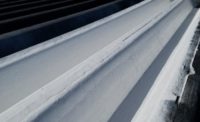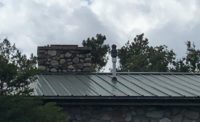There has been a significant increase in the use of roof coatings in the past decade. The increase in the use of roof coatings on commercial roof applications can be linked to environmental concerns and technical advancements. Coatings have been used to restore existing roof systems, act as a surfacing that shields the membrane from erosion caused by rain, snow, sleet and hail and to reflect ultra-violet radiation.
When properly applied, coatings can provide significant advantages to a roof system. Coatings have been documented to expand the service life of existing roofs, improve a buildings energy efficiency, resist degradation from chemical attack and ultra-violet radiation and eliminate the formation of small cracks associated with these degenerative conditions. Improper coating application leads to premature coating failures, which could lead to the demise of the roof system.
Successful roof coating applications are based on the following preparation, application, and inspection guidelines.
General Conditions
The most important criteria of coating application is adhesion to the substrate. To achieve full bonding of the coating the surface must be properly prepared. Preparation requirements are contingent upon the type of surface that the coating is being applied over and the age of the applied surface. For the best results, check with the coating manufacturer to determine what the age requirements are for application on different surfaces.
Typically, aluminum roof coatings should not be applied over asphalt glaze or flood coat surfaces for three months to allow for the evaporation of solvents. Asphalt emulsions can be coated within five to 14 days of application depending on how the ambient temperatures affect the curing. Recent studies have indicated that modified bitumen surfaces should be coated prior to aging. Application of waterborne coatings should be applied in accordance with the manufacturer’s requirements.
Weather Conditions
The ambient weather conditions also play a critical role in the coating application process. Most coatings should not be applied when the ambient weather temperatures are below 40 degrees Fahrenheit. This is primarily true of waterborne coatings. Some solvent-based coatings can be applied in lower temperatures—if they are properly stored in a heated environment—prior to application.
The concern in applying coatings in lower temperatures is that dew or moisture can accumulate over the surface and interfere with the bonding of the coating. Hot temperatures—over 110 degrees Fahrenheit—can also be detrimental to the coating application. Application in extreme temperatures could result in the coating curing too quickly contributing to streaks. Coatings should not be applied if rain or precipitation is forecasted within 24 hours of application.
Surface Condition
Preparation of the surface is the most critical component of the application process. The surface must be clean and free of all moisture, contaminants, debris, oils, and loose particles. Surface contaminants create impediments to the coating adhesion, which result in disbondment, or peeling of the coating. The surface can be cleaned of all contaminants by power washing, brooming, or vacuuming. Power washing is typically used to remove heavier debris or remnants from existing coatings.
If contaminants on the surface are extensive, a primer may be required prior to the coating application. The primer must be dry (fully cured) prior to the application of the coating. It is also important to note that not all primers are suitable for all coatings. Some primers are incompatible with specific coatings. The coating manufacturer should be consulted prior to surface cleaning to determine what cleaning methods are acceptable and if/what primer is required.
Coatings should only be applied on roof surfaces with positive drainage. Ponded water typically reduces the service life of the coating and contributes to a reduction of the coatings mil or film thickness, peeling and delamination. Ponded water should be eliminated from the roof surface through additional drains or tapered insulation prior to the coating application. Some manufacturers have developed products that are specifically made for application in ponded areas. These types of products can be considered if there is no other means of eliminating ponded water.
Application Methods
The initial step in the coating application process is to properly mix the coating prior to—and during—the coating application. Pigments used in the manufacturing of the coating settle during storage of the coating. Properly mixing the coating allows for uniform color and optimum reflectivity. Most manufacturers recommend the use of mechanical mixers to properly mix the coating while it is still in the pail. The mixer should have a blade that is designed for use with fibered products not regular paint blades.
Another important criteria prior to application phase is that the contractor should use the coating in its manufactured state. In other words, do not mix solvents or water into the coating to thin it out. The coatings are manufactured with special formulations to achieve optimum performance. The addition of thinners can contribute to premature failures or shortened service life. Thinning the coating may decrease the final film thickness leading to improper weathering.
There are three accepted methods of coating application: brush, roller, or spray equipment. The brush should be a three or four knot roofers brush or a soft bristled broom. If a roller is used, it should have a medium nap roller cover. The application methods with brushes and rollers are similar in that the strokes should be finished in the same direction to achieve cohesive esthetics.
The spray equipment used can be any type that is capable of spraying the coating in an even application. The most prominent type used in roof coating applications are airless sprayers. The viscosity of the coating material, the internal diameter size of the hose and the length of the hose are important determining factors for the proper selection of the spray equipment. For guidance with the spray equipment selection process consult the material manufacturer for the type of sprayer that provides the best performance with their materials.
Coverage
All roof coatings should be applied in accordance with the manufacturers latest printed specifications and guidelines. It is important that the contractor applies the coatings at rates specified by the manufacturer. The manufacturers have tested their products and they know what their optimum performance rates are. Too much coating or too little coating will result in poor performance and premature failure. Type I non-fibered aluminum coatings are typically applied at a rate of 0.5 to 1.5 gallons per square and Type II or III fibered aluminums are usually applied at a rate of 1 to 2 gallons per square. Waterborne coatings are typically applied at a rate of 1 to 2 gallons per square.
The coatings should be applied in a uniform and even application over the entire surface. Foot traffic over the completed coating application should be avoided until the material is fully cured. Curing depends on the ambient temperatures with the quickest curing occurring in dry, moderate temperatures.
Roof coatings are applied to meet the manufacturers required ‘mil thickness’, which is thousands of an inch. In order to determine the amount of coating material required to achieve the required mil thickness a “Coatings Consumption” formula can be calculated. The calculation is based on the fact that all liquids cover 1,604 square feet at 1 mil thickness per gallon.
The formula can be calculated to determine coating coverage per square feet or coating coverage per mil thickness. To determine square foot coverage, 1,604 is divided by desired mil thickness. To determine mil thickness; 1,604 is divided by desired square foot coverage.
Techniques for Inspecting and Testing Roof Coating Applications
Compliance with the proper application rate is essential to the success of the coating. Coating application rates can be monitored through various inspection techniques. Visual inspection can determine if the coating is applied in an even application rate over the entire surface.
It also provides the opportunity to ensure that proper surface preparation was completed; a critical component of the coating application. The only aspect that visual inspections lack are exact determination of mil thickness. This can be accomplished through the use of gauges and calculations.
Designers and/or manufacturers’ will typically provide the number of dry film thickness mils required for the project. The most common method of determining the actual dry film thickness of a coating application is through a two-step process that requires the use of a wet mil gauge and calculation of a formula.
Physical verification is completed through the use of a wet mil gauge, which is typically available through the coating manufacturer or supplier. The wet mil gauge is a metallic piece that is the approximate size of a credit card. There are a series of teeth at the total perimeter of the gauge that are grooved open to various mil thicknesses.
The testing method utilizing the gauge is simple and quick to perform. Simply insert the gauge into the coating immediately after application. Press the gauge into the coating for an instant and vertically withdraw it. Upon removal, note the deepest tooth having coating residue on it and the next highest tooth that does not have residue. The wet film thickness is considered to be the level between these two readings.
Once the wet film thickness is determined, it is multiplied by the percent volume solids rate that is provided by the coating manufacturer.
Wet Film Thickness x Percent Volume Solids = Dry Film Thickness (DFT)
The dry film thickness must be determined for each required layer of coating application; i.e. base coating and top coating. The dry film thickness of each layer is added to determine the total dry film thickness of the coating system.
It is important that the gauge is applied immediately after the coating application because any delay in this process may allow for evaporation of volatile solvents, which will provide false readings. It should also be noted that winds in excess of 20 mph can reduce thickness by 20 percent to 30 percent.







